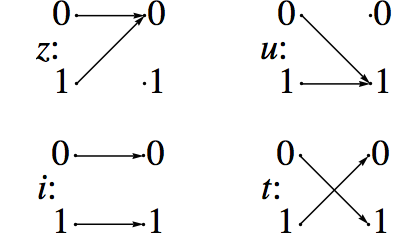\(M=[\mathcal{P}\{1,2,3\};\cap ]\) is isomorphic to \(M_2=\left[\mathbb{Z}_2^3;\cdot \right]\text{,}\) where the operation in \(M_2\) is componentwise mod 2 multiplication. A translation rule is that if \(A\subseteq \{1,2,3\}\text{,}\) then it is translated to \(\left(d_1,d_2,d_3\right)\) where
\begin{equation*}
d_i=\left\{
\begin{array}{cc}
1 & \textrm{ if } i\in A \\
0 & \textrm{ if } i\notin A \\
\end{array}
\right.
\end{equation*}
Two cases of how this translation rule works are:
\begin{equation*}
\begin{array}{lr}
\begin{array}{c}
\{1, 2, 3\}\quad\textrm{ is the identity for } M_1\\
\updownarrow \\
(1,1,1) \quad\textrm{ is the identity for }M_2\\
\end{array}
&
\begin{array}{c}
\{1, 2\}\cap \{ 2, 3\}=\{2\}\\
\updownarrow \\
(1, 1, 0) \cdot (0, 1, 1) = (0, 1, 0)\\
\end{array}\\
\quad
\end{array}\text{.}
\end{equation*}
